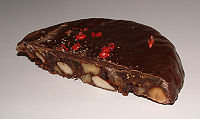| This article needs additional citations for verification. Please help improve this article by adding citations to reliable sources. Unsourced material may be challenged and removed. Find sources: "Panforte" – news · newspapers · books · scholar · JSTOR (July 2024) (Learn how and when to remove this message) |
 Traditional style panforte Traditional style panforte | |
| Type | Confectionery |
|---|---|
| Place of origin | Italy |
| Region or state | Tuscany |
| Main ingredients | Nuts, honey, sugar, fruits, spices |
| Variations | Panpepato |
Panforte is a chewy Italian dessert containing fruit and nuts. It is similar to a Florentine but is much thicker and is a little like a lebkuchen. Known throughout Italy, it is an Italian Christmas tradition associated especially with the province of Siena.
History
Panforte dates back to at least the 13th century, in the Italian region of Tuscany. Documents from 1205, conserved in the State Archive of Siena, attest that bread flavored with pepper and honey (panes melati et pepati) was paid to the local monks and nuns of the monastery of Montecellesi (modern Monte Celso, near Fontebecci) as a tax or tithe which was due on 7 February that year.
Literally, panforte means 'strong bread', derived from the Latin fortis, which refers to the spicy flavour. Originally, the Sienese called it panpepato ('peppered bread'), due to the strong pepper used. The original dessert was composed of wheat flour, honey, spices, dried figs, jam and pine nuts and was flavored with pepper.
Production
| This section does not cite any sources. Please help improve this section by adding citations to reliable sources. Unsourced material may be challenged and removed. (July 2024) (Learn how and when to remove this message) |
The process of making panforte is fairly simple. Sugar is dissolved in honey and various nuts, fruits and spices are mixed together with flour and baked in a shallow pan. The finished disc is dusted with icing sugar. Commercially produced panforte often have a band of rice paper around the edge.
Many shops in Italy produce panforte, each recipe being their own zealously guarded interpretation of the original confection and packaged in distinctive wrapping. Usually, a small wedge is served with coffee or a dessert wine after a meal, although some enjoy it with their coffee at breakfast.
In Siena—which is regarded by many, if not most inhabitants of that city, as the panforte capital of Italy—it is sometimes said that panforte should properly contain seventeen different ingredients, seventeen being the number of Contrade (wards) within the city walls.
Protected geographical indication
In 2013, panforte received the protected geographical indication (PGI) status.
-
 Panforte with chocolate
Panforte with chocolate
-
 Panforte with marzipan at a shop in San Gimignano, Italy
Panforte with marzipan at a shop in San Gimignano, Italy
See also
References
- "Panforte". epicurious.
- "Storia - History (Fiore di Siena)" (PDF). Retrieved 2020-08-21.
- "I dolci senesi tra storia e leggenda" (PDF). Retrieved 2020-08-21.
- Atti, volumi 1-2. Accademia dei fisiocritici in Siena. Sezione agraria. 1933.
- "I dolci più antichi: Panforte e Panpepato". Archived from the original on 2023-01-02. Retrieved 2020-08-21.
- "Panforte e panpepato: i dolci più antichi". Archived from the original on 2023-01-02. Retrieved 2020-08-21.
- "Agriculture and Rural Development". Retrieved 2019-01-05.
External links
- Panforte Di Siena—history
| Nut and seed confections | |||||||||
|---|---|---|---|---|---|---|---|---|---|
| Whole or crushed |
| ||||||||
| Ground | |||||||||
| Puréed | |||||||||
| Filling, topping or base |
| ||||||||
This Italian dessert–related article is a stub. You can help Misplaced Pages by expanding it. |
This Italian cuisine–related article is a stub. You can help Misplaced Pages by expanding it. |